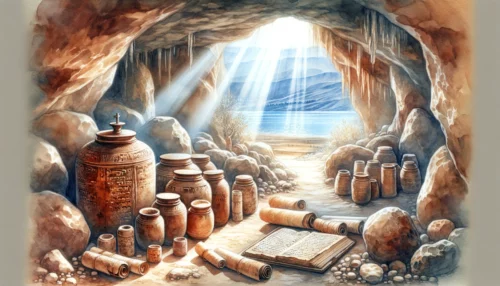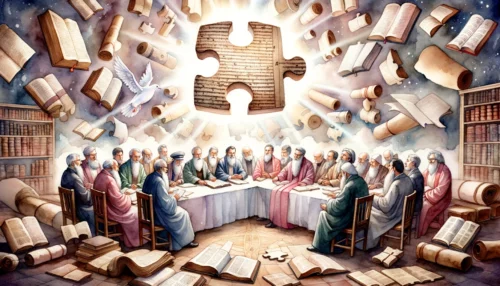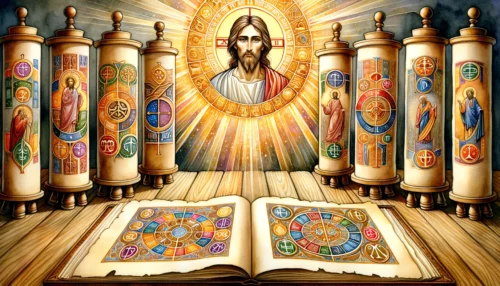When considering the life of Jesus Christ, our focus typically hones on His ministry, teachings, and the profound sacrifice He made for humanity’s redemption. Yet, an often overlooked, but equally compelling aspect of His earthly existence lies in His immediate family – specifically, the question of His possible siblings. In this article, we aim to explore this intriguing question from a Biblical perspective, addressing the query: Did Mary have children after Jesus?
The Biblical Evidence for Jesus’s Siblings
As we begin to probe the Scriptures, we encounter several passages that suggest Jesus may have had biological siblings. These potential siblings are usually referred to as ‘the brothers of Jesus,’ and occasionally ‘the sisters of Jesus’ are also mentioned.
Let’s first look at the Gospel of Matthew, which lists James, Joseph (or Joses), Simon, and Judas as brothers of Jesus (Matthew 13:55). The Gospel of Mark echoes this listing of Jesus’s brothers, again mentioning James, Joses, Judas, and Simon (Mark 6:3). In these Gospel accounts, the mention of brothers and sisters is made when people are expressing disbelief at Jesus’s teachings, astonished that someone from their local community would speak with such authority and wisdom.
The Acts of the Apostles, in describing the period after Christ’s ascension, refer to the apostles coming together in prayer, along with Mary, the mother of Jesus, and his brothers (Acts 1:14). This passage implies that Jesus’s brothers were part of the early Christian community.
Paul’s letters also contain references that shed light on this topic. In his letter to the Galatians, Paul recounts his journey to Jerusalem, where he met with James, referred to as the Lord’s brother (Galatians 1:19). This James is often identified with the James who led the Christian community in Jerusalem and is considered the author of the Epistle of James in the New Testament.
The Gospel of John provides a somewhat ambiguous perspective. It describes a situation where Jesus’s brothers advise Him to go to Judea for the Feast of Tabernacles, expressing skepticism about His miracles (John 7:3-5). Later, near the crucifixion, Jesus entrusts the care of His mother Mary to the apostle John (John 19:26-27), which raises questions about the status of His brothers and why they were not given this responsibility.
While these passages seem to imply that Jesus had biological siblings, some scholars interpret them differently, considering cultural and linguistic factors. But for now, it is clear that the Bible does mention individuals referred to as Jesus’s brothers and sometimes sisters.
The New Testament refers to people named James, Joseph (or Joses), Simon, and Judas as brothers of Jesus. Passages in the Gospels of Matthew and Mark, the Acts of the Apostles, and Paul’s letters all contain these mentions. The Gospel of John includes interactions between Jesus and his brothers but also presents the intriguing episode of Jesus entrusting Mary’s care to the Apostle John. While these references indicate that Jesus had siblings, the precise nature of these relationships is a topic of ongoing discussion among scholars.
Understanding the Greek Terminology: “Adelphos” and “Adelpha”
Delving into the original language of the New Testament, which is Greek, sheds light on the nature of the relationships discussed earlier. The Greek words “adelphos” and “adelpha” are often used in the New Testament, and they translate to ‘brother’ and ‘sister’ respectively in English.
Although the literal translation of these words is ‘brother’ and ‘sister,’ the usage in ancient Greek, and particularly in the context of the New Testament, can be more nuanced. These terms could denote a variety of relationships, from biological siblings to more extended familial ties and even close relationships within a community.
Let’s look at the instances where “adelphos” is used in the New Testament, outside of those referring to Jesus’s siblings. The word is often used to denote a sense of spiritual kinship among believers (1 Corinthians 1:10). It is also employed to refer to fellow countrymen or people of the same ethnic group (Acts 3:17). Similarly, “adelpha” is used to refer to female members of the Christian community (Romans 16:1).
In a similar vein, the term “adelphos” is used in Septuagint, the Greek translation of the Old Testament, to describe various relationships that would not fall under the category of biological siblings in English. For instance, it refers to the relationship between Abraham and Lot (Genesis 13:8), even though Abraham was Lot’s uncle.
It’s evident that the words “adelphos” and “adelpha” carried a range of meanings in the original Greek context, beyond just denoting biological siblings. This gives us a nuanced understanding of how relationships were perceived and described in the time of the New Testament.
The Greek words “adelphos” and “adelpha,” typically translated as ‘brother’ and ‘sister’ in English, carry broader connotations in the New Testament. These terms could indicate not just biological siblings, but also extended familial relations and close bonds within a community. Their use in other parts of the New Testament and the Septuagint suggests a wide range of possible relationships. This understanding is key in interpreting the passages that refer to the ‘brothers’ and ‘sisters’ of Jesus.
The Theological Debate: Brothers or Cousins?
Given the diverse connotations of the terms “adelphos” and “adelpha”, interpretations of the familial relationships around Jesus vary among Christian traditions. This distinction has led to interesting debates in theological circles, primarily centered on whether the references to the brothers and sisters of Jesus imply biological siblings or cousins.
One perspective, particularly upheld by the Roman Catholic tradition, posits that Mary, the mother of Jesus, remained a perpetual virgin throughout her life. This belief necessitates an interpretation of “adelphos” and “adelpha” as referring to close relatives of Jesus, likely cousins, rather than direct siblings. It’s worth noting that the Greek language of the New Testament doesn’t have a specific word for ‘cousin,’ thereby necessitating the use of “adelphos” or “adelpha” for such relationships. This argument is also supported by the mention of another Mary, described as the mother of James and Joses in Mark’s Gospel (Mark 15:40), implying that these ‘brothers’ could be Jesus’s cousins and not His biological brothers.
On the other hand, many Protestant traditions interpret the brothers and sisters of Jesus as His biological siblings, children of Mary and Joseph born after Jesus. This perspective leans into the more literal interpretation of “adelphos” and “adelpha” as biological siblings. It is often pointed out that the Gospels make repeated references to Mary, the mother of Jesus, His brothers, and His sisters, as a group distinct from the apostles and other followers (Matthew 12:46-50, Mark 3:31-35).
The Orthodox tradition provides a third interpretation, positing that the brothers of Jesus were Joseph’s children from a previous marriage, thereby making them Jesus’s stepbrothers. This interpretation also upholds the belief in Mary’s perpetual virginity.
The exact nature of the relationship between Jesus and those referred to as His ‘brothers’ and ‘sisters’ in the New Testament has been a subject of theological debate. The Roman Catholic tradition often interprets these siblings as Jesus’s cousins, supporting the belief in Mary’s perpetual virginity. In contrast, many Protestant traditions interpret them as Jesus’s biological siblings. The Orthodox tradition introduces another perspective, viewing them as Jesus’s step-siblings, children of Joseph from a previous marriage.
Navigating the Family Ties of Christ
The discussion around the familial relationships of Jesus, particularly those called His ‘brothers’ and ‘sisters’ in the New Testament, highlights the complexity and nuance of Biblical interpretation. The varying understandings across Christian traditions – whether they are viewed as biological siblings, cousins, or step-siblings – underscore the richness of our faith and the diversity of thought it accommodates. In the grander scheme of our faith, this matter reminds us that the Scriptures often present us with more questions than answers, continually inviting us to engage deeply with our beliefs.
To further contemplate this topic, consider these questions:
- How does the understanding of Jesus’s familial relationships affect your perspective on His life and teachings?
- What insights can you gain from the diverse interpretations within Christian traditions?
- What does this discussion reveal about the process of Biblical interpretation and its significance in our faith?
May the mysteries of our faith inspire you, not as unanswered questions, but as an invitation to delve deeper, sparking a continuous curiosity that draws you closer to understanding the Divine. Be motivated by the richness of our faith, always open to new discoveries that nourish your spiritual journey.














